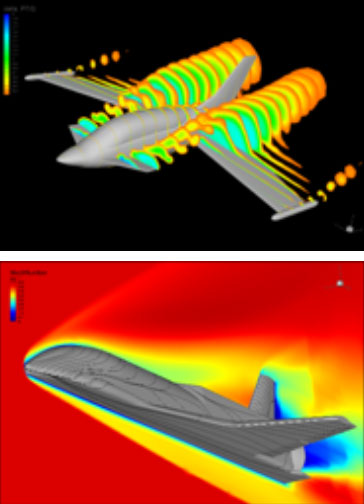Computational Fluid Dynamics (CFD) is the process of calculating how a fluid, usually air, flows around an object. There are a number of different methods. These include quick and simple lifting line to full Navier-Stokes volume flow with heat transfer and reacting gas chemistry.
Computational Fluid Dynamics (CFD) Design Services
- External and Internal Aerodynamic Flow Modeling
- Subsonic, Transonic, Supersonic, Hypersonic including Chemical Reacting Non-Equilibrium Flows
- Aerodynamic Impact of a Proposed Change
- Aircraft Performance Prediction, Measurement and Model Validation
- Evaluation of Aircraft Stability and Control
- Propulsion Installation Effects
- Installed Performance of Jet Engines
- Lofting
- Wind Tunnel Testing
- Low-Speed, Transonic, High-Speed Wind Tunnel Planning, Testing and Result Analysis
- Free Surface Interaction
- Preliminary Design Analysis
How Does TLG Ensure Accurate CFD Analysis?
TLG has extensive experience in practical CFD application and has validated results against tunnel and flight test data whenever possible. While CFD programs have become more efficient, it is important to ensure the answers are correct. It is vital that the application user has a thorough understanding of the program, including the physics being solved and an extensive experience base of validation cases. Therefore, TLG CFD solutions are always sanity checked against a simpler method, such as empirical integration, and reviewed by our in-house Chief Aerodynamicist.
What CFD Applications Does TLG Support?
There are now a huge number of non-aerospace CFD applications ranging from electronics cooling to soccer ball design. At TLG, our application experience is primarily in aircraft design and analysis including airfoil design, engine inlets and full aircraft analysis at low speed, transonic and supersonic Mach numbers. In addition, TLG has also analyzed railcars and underwater vehicles and is continuing to expand in this area.
CFD Tools
At TLG, we employ a range of CFD tools including MSES for 2D airfoil optimization and analysis, Vortex Lattice methods for stability derivatives and initial design and the 3D full Navier-Stokes STAR-CCM+ flow solver which is capable of unsteady flow calculations with heat transfer and 6DOF fluid-body interaction.


